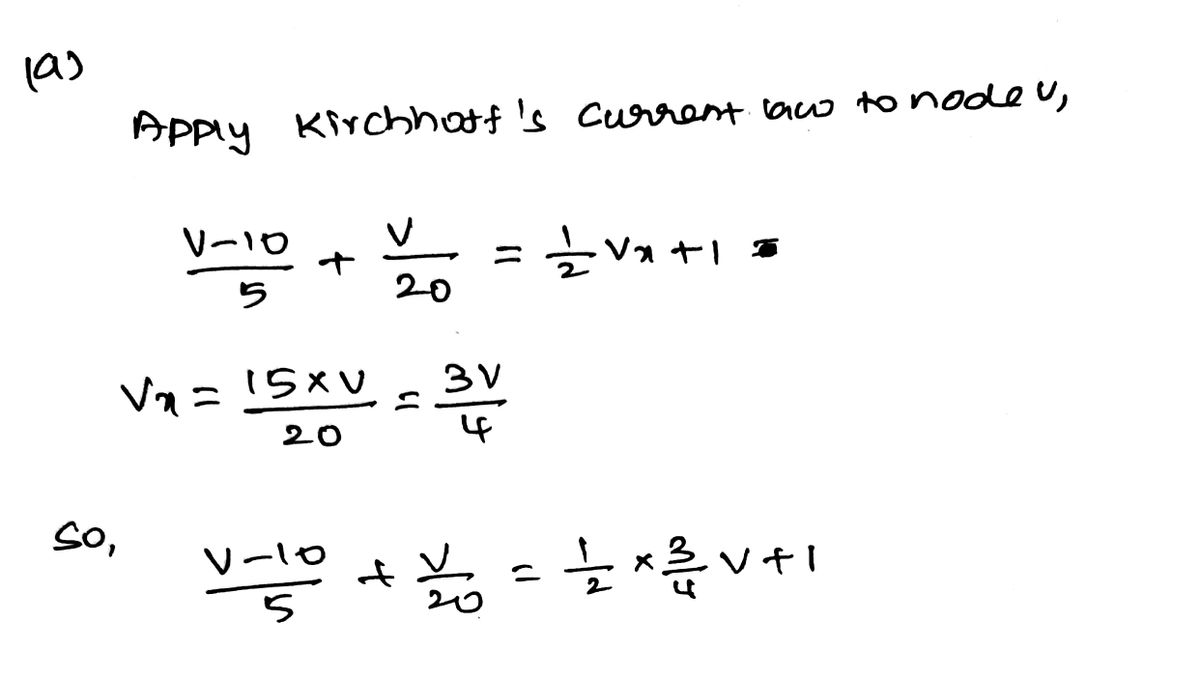Find the Thevenin equivalent circuit as seen at terminals a-b, as follows. (a) Write a nodal equation at V when the terminals are left open, and solve for V. Compute currents and check V using KCL. What is the open-circuit voltage V, between a and b? (b) Write a nodal equation at V when the terminals are shorted, and solve for V. Compute currents and check V using KCL. What is the short-circuit current I (c) Compute R,, = Vo/ and draw the Thevenin equivalent circuit with V + on top (closer to node a) and - on the bottom (closer between a and b? th node b).
Find the Thevenin equivalent circuit as seen at terminals a-b, as follows. (a) Write a nodal equation at V when the terminals are left open, and solve for V. Compute currents and check V using KCL. What is the open-circuit voltage V, between a and b? (b) Write a nodal equation at V when the terminals are shorted, and solve for V. Compute currents and check V using KCL. What is the short-circuit current I (c) Compute R,, = Vo/ and draw the Thevenin equivalent circuit with V + on top (closer to node a) and - on the bottom (closer between a and b? th node b).
Power System Analysis and Design (MindTap Course List)
6th Edition
ISBN:9781305632134
Author:J. Duncan Glover, Thomas Overbye, Mulukutla S. Sarma
Publisher:J. Duncan Glover, Thomas Overbye, Mulukutla S. Sarma
Chapter6: Power Flows
Section: Chapter Questions
Problem 6.61P
Related questions
Question
Hello, I am looking for help on parts A-C, please show all work and verification using KCL, thanks in advance :)

Transcribed Image Text:Consider the following circuit:
V
a
202
10V
152
1A
b
Find the Thevenin equivalent circuit as seen at terminals a-b, as follows.
(a) Write a nodal equation at V when the terminals are left open, and solve for V. Compute
currents and check V using KCL. What is the open-circuit voltage V, between a and b?
(b) Write a nodal equation at V when the terminals are shorted, and solve for V. Compute
currents and check V using KCL. What is the short-circuit current I between a and b?
sc
(c) Compute R, = Vo/l and draw the Thevenin equivalent circuit with V + on top (closer
to node a) and – on the bottom (closer to node b).
(d) Compute the current from a to b through a 40 "load" resistor connected to the terminals.
(e) What value of the load resistance should you avoid? Why?
(f) Compute the power delivered by a 12V source connected to the terminals, + at a.
Show your work and verify.
NOTES and SUGGESTIONS
When there is a dependent source, as here, the value of Rh is not restricted, so you should
not make any assumptions about it.
Use a voltage divider to compute V, as a function of V.
Keep in mind that the 202 resistor in series with the 1A source does not affect the voltage
V, so it should not be included in either of your nodal equations.
Choose different variable names for the two values of V in order to avoid confusion.
For parts (d) through (f), assume that the current is "clockwise", i.e., from a to b, and work
symbolically using Vh and Rh. That is, don't let yourself be distracted by the signs.
You may use MATLAB or Python to calculate values, but you must include your script and
output as PDF files for full credit. There must also be a "hand calculation" showing where
your equations came from. The hand calculation should agree with your script.
Expert Solution
Step 1

Trending now
This is a popular solution!
Step by step
Solved in 3 steps with 5 images

Knowledge Booster
Learn more about
Need a deep-dive on the concept behind this application? Look no further. Learn more about this topic, electrical-engineering and related others by exploring similar questions and additional content below.Recommended textbooks for you

Power System Analysis and Design (MindTap Course …
Electrical Engineering
ISBN:
9781305632134
Author:
J. Duncan Glover, Thomas Overbye, Mulukutla S. Sarma
Publisher:
Cengage Learning

Power System Analysis and Design (MindTap Course …
Electrical Engineering
ISBN:
9781305632134
Author:
J. Duncan Glover, Thomas Overbye, Mulukutla S. Sarma
Publisher:
Cengage Learning